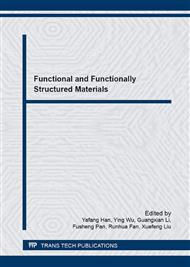[1]
Niu Decun. Application of LED in the lighting, Engineering and Technology, 2009, 6(3): 33.
Google Scholar
[2]
Arik M, Becker C, Weaver S, et a1. Thermal management of LEDs: package to system. Proceedings of the SPIE-The International Society for Optical Engineer, 2004, 5187: 64-75.
Google Scholar
[3]
Yang L Q, Jiang S, Wang W H, et a1., Thermal analysis of high power GaN-based LEDs with ceramic package. Thermo-chemical Acts, 2007(455): 95-99.
Google Scholar
[4]
Narendran N, Gu Y M., Life of LED-based white light sources. Display Technol., 2005, 1(1): 167-171.
DOI: 10.1109/jdt.2005.852510
Google Scholar
[5]
Nougeria E, Vazquez M, Nunez N., Evaluation of MGalnP LEDs reliability based on accelerated tests. Mieroelec Reliab, 2009, 49(9-11): 1240-1243.
Google Scholar
[6]
SUN Chun Lei. Discuss of Rugged AMLCD Technology. Journal of Human Light Industry college, 2002, 14(4): 20-24.
Google Scholar
[7]
Rao Lianjiang, Application of ceramic material in the light-emitting diode lighting. Lamps and Lighting, 2011, 3(1): 6.
Google Scholar
[8]
Carl H Z. New material options for 1ight-emitting diode packaging. 1ight-emitting Diodes: Research, Manufacturing, and Applications VIII. San Jose CA, USA: Society of Photo-optical Instrumentation Engineers, 2004, 173-182.
DOI: 10.1117/12.529192
Google Scholar
[9]
HE Yong-xiang, JIN Xiao-ping, YANG Song, HUANG Da-kang., Application for LED heat dissipation with ceramic substrate based on gradient layer for metal penetration, Journal of China University of Metrology, 2012, 23(4): 363.
Google Scholar
[10]
Bae J W, Kim W, Cho S H. The properties of AlN-filled epoxy molding compounds by the effects of filler size distribution. J Mater Sci, 2000, 35: 5907-5913.
Google Scholar
[11]
Wong C P, Bollampally R S., Comparative study of thermally conductive fillers for use in liquid encapsulants for electronic packaging. IEEE Trans Adv packg, 1999, 22(1): 54-59.
DOI: 10.1109/6040.746543
Google Scholar
[12]
KANG Xue-qin, SUN Zhi. Heat Conduction Performance of Ceramic Fiber Reinforced Polyolefin Composite. China Plastics Industry, 2004, 32(3): 52.
Google Scholar
[13]
Zhang Xiaohui, Research for thermal properties and Mechanism of electric polymer materials. Xi'an Jiaotong University. (1999).
Google Scholar
[14]
X Lu, G Xu, Thermally Conductive polymer Composites for Electronic packaging, J Appl Polym Sci., 1997, 65: 2733-2738.
DOI: 10.1002/(sici)1097-4628(19970926)65:13<2733::aid-app15>3.0.co;2-y
Google Scholar
[15]
2012 the global LED lighting output value of up to MYM 87billion. http: /www., simaoled. com/english/news_show. asp? mid=6&nc_id=I&ncl_id=2&n_id=430.
Google Scholar
[16]
Curran J A, Clyn T W., The thermal conductivity of plasma electrolytic oxide coatings on aluminum and magnesium, Surf Coat Techn, 2005, (223): 177.
Google Scholar
[17]
Curran J A, Clyn T W. Thermo-physieal properties of plasma electrolytic oxide coatings on aluminum I-J3. Surf Coat Techn, 2005, (223): 168.
Google Scholar
[18]
Nagai Y, Lai G C. Thermal conductivity of epoxy resin filled with particulate aluminum nitride powder. J Ceram Soc Jap, 1997, 105(3): 197-200.
DOI: 10.2109/jcersj.105.197
Google Scholar


